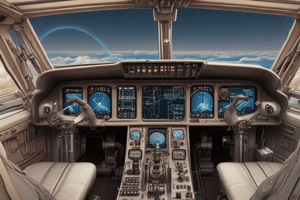Podcast
Questions and Answers
What happens when an initial change of course error is detected?
What happens when an initial change of course error is detected?
- The autopilot is disengaged.
- The vessel immediately stops its movement.
- A corrective port rudder command is applied.
- A corrective starboard rudder command is applied. (correct)
What is the effect of applying a combination of proportional and derivative control?
What is the effect of applying a combination of proportional and derivative control?
- There will be an immediate stop of the rudder adjustments.
- The vessel returns to its original course with damped oscillations. (correct)
- The autopilot system will take no action.
- The vessel will drift indefinitely from its set course.
How does the autopilot determine the rudder position?
How does the autopilot determine the rudder position?
- By continuously monitoring the rudder reference unit. (correct)
- Through manual control inputs from the operator.
- Based on the last known heading without real-time adjustments.
- Using only GPS data without heading sensors.
In AUTO modes, what is continuously compared to maintain the vessel's course?
In AUTO modes, what is continuously compared to maintain the vessel's course?
What occurs when the vessel drifts off course?
What occurs when the vessel drifts off course?
What does integral control rely on for its actions?
What does integral control rely on for its actions?
What happens to the rudder when the vessel crosses its original course during a starboard turn?
What happens to the rudder when the vessel crosses its original course during a starboard turn?
What effect does derivative control have on the rate-of-change during the initial course error adjustment?
What effect does derivative control have on the rate-of-change during the initial course error adjustment?
What is the primary function of an autopilot system?
What is the primary function of an autopilot system?
Which control method applies a rudder correction proportional to the positional error?
Which control method applies a rudder correction proportional to the positional error?
What is a potential downside of using only proportional control in an autopilot system?
What is a potential downside of using only proportional control in an autopilot system?
How does derivative control differ from proportional control?
How does derivative control differ from proportional control?
What happens when the vessel approaches its course using proportional control?
What happens when the vessel approaches its course using proportional control?
What type of data does the autopilot utilize for its control function?
What type of data does the autopilot utilize for its control function?
What is the primary challenge with proportional control when steering a vessel?
What is the primary challenge with proportional control when steering a vessel?
Which of the following statements about autopilot control methods is true?
Which of the following statements about autopilot control methods is true?
Flashcards are hidden until you start studying
Study Notes
Introduction to Autopilot
- Autopilot is an automatic device for steering a vessel, helping maintain an intended heading.
- Allows operators to perform navigational checks, make trim adjustments, or relax during a voyage.
- Uses input from a gyro or magnetic compass to compare intended course against actual course, applying rudder corrections as needed.
Main Control Methods
- Three primary control functions ensure accurate course maintenance: Proportional control, Derivative control, and Integral control.
Proportional Control
- Rudder movement is proportional to the positional error from the course line.
- Full rudder is applied upon detecting an error, countering the vessel’s deviation.
- Results in oscillation as the vessel overshoots the course, causing fuel inefficiency.
- Typically leads to erratic steering behavior, balancing back and forth around the desired course.
Derivative Control
- Rudder adjustment is based on the rate of change of course deviation.
- Initial error prompts a corrective rudder command, which decreases as the vessel approaches the desired course.
- Allows for continuous adjustment until external forces necessitate further autopilot operations.
- More stable behavior compared to Proportional control alone, leading to smoother course correction.
Integral Control
- Combines Proportional and Derivative controls for optimal course correction.
- The initial error is managed by signals from both control methods, producing a damped oscillation in the vessel's path.
- Continuously senses heading errors over time, applying a steady helm adjustment to maintain course.
Principle of Operation
- In AUTO mode, heading information from a sensor is compared with a set course.
- Course deviations create an imbalance at a comparator, adjusting rudder position accordingly.
- When a balanced condition is achieved, rudder adjustments stop.
- A rudder reference unit tracks position, monitored by a processor unit to ensure effective course management.
Autopilot System Overview
- The autopilot system utilizes feedback loops and control methods for accurate navigation.
- Continuous monitoring and adjustments enhance control efficiency and reduce the need for manual steering interventions.
Studying That Suits You
Use AI to generate personalized quizzes and flashcards to suit your learning preferences.




